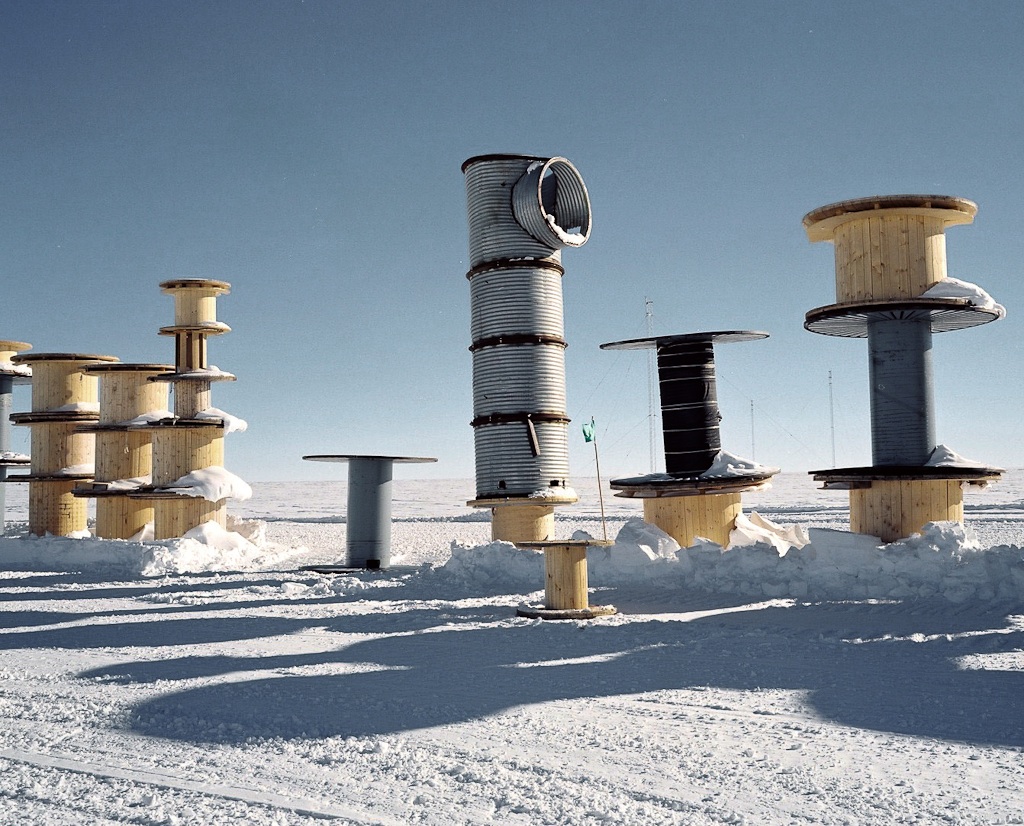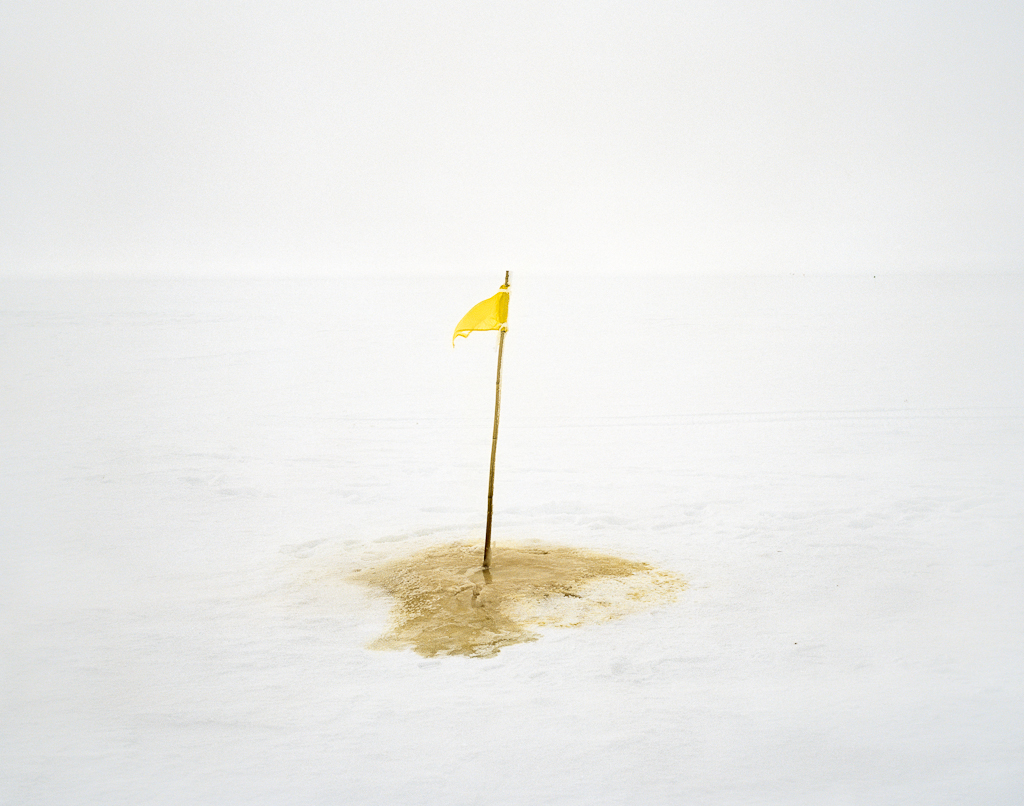“Because it’s there.”
Not good enough.
The traditional explanation for our species’ imperative to go to the ends of the earth no longer holds, and it hasn’t held for a long time. An isolated population or two might still be lurking out there, somewhere, in a jungle or on an ice floe, harboring a “Because it’s there” impulse—though, if so, they haven’t done a very good job of acting on it. But for the rest of us, it would be difficult to find a place on the surface of the Earth that’s not terra cognita.
I’ve found myself thinking about the ends of the earth lately as I’ve been writing an essay for a book of photographs by the New Zealand photographer Anne Noble. Anne and I were both recipients of an Antarctic Artists and Writers Program grant from the National Science Foundation in 2008. My grant led to a chapter in my book The 4 Percent Universe, a magazine article, and a couple of LWON posts. Anne’s grant is leading her to a suite of three books. The first, Ice Blink (coming in April), juxtaposes images of genuine Antarctic environments with images of artificial ones, such as installations at museums and aquariums. The second book—the one for which I am writing the essay—captures the human imprint on Antarctica, including the examples from the South Pole that accompany this post.
 Even among the landmarks that remained inaccessible for most of human history due to being among the farthest or the harshest, Antarctica occupies a class by itself. It’s both: farthest; harshest. It’s a continent twice the size of Australia, almost as expansive as the continental United States and Mexico combined, yet the combination of remote location and inhuman environment left Antarctica unseen by human eyes until well into the 1800s—four centuries after the dawn of the European Age of Exploration. The interior of the continent remained impenetrable until the first decade of the twentieth century. And the 1911 race to the Pole itself has come to epitomize the “Because it’s there” imperative at its most extreme—at least as much, to my mind, as the race to climb Mount Everest, the origin of the whole “Because it’s there” conceit. The purpose of the Roald Amundsen and Robert Scott expeditions was to plant a flag and get the hell out.
Even among the landmarks that remained inaccessible for most of human history due to being among the farthest or the harshest, Antarctica occupies a class by itself. It’s both: farthest; harshest. It’s a continent twice the size of Australia, almost as expansive as the continental United States and Mexico combined, yet the combination of remote location and inhuman environment left Antarctica unseen by human eyes until well into the 1800s—four centuries after the dawn of the European Age of Exploration. The interior of the continent remained impenetrable until the first decade of the twentieth century. And the 1911 race to the Pole itself has come to epitomize the “Because it’s there” imperative at its most extreme—at least as much, to my mind, as the race to climb Mount Everest, the origin of the whole “Because it’s there” conceit. The purpose of the Roald Amundsen and Robert Scott expeditions was to plant a flag and get the hell out.
Today, if you sit in the cafeteria at the Amundsen-Scott South Pole Station—the headquarters for the U.S.’s scientific research at this end of the earth—and look out the large windows at the geographical pole a few dozen yards away, you can’t help but notice what else is out there, in the distance: the encampments of today’s polar explorers. They’re tourists who have paid upward of $50,000 to be deposited by charter plane at the 88 or 89 degrees south latitude, from which point they ski to the Pole. There, as the website of one charter service promises, they will “enjoy a great celebration including champagne, dozens of photographs to document our success, and the prized call home from the bottom of the world.“ When they’re done, they’ll board a plane on the ice runway on the other side of the Station.
As you sit in the cafeteria, you can lament the tents that interrupt the line of the horizon. Interlopers! Opportunists! Privileged despoilers of views!
But you can also ask, What of their view?
They’re looking at a building that’s the size of a cruise ship, that sleeps 200, that houses a gymnasium and a state-of-the-art fitness center and a computer lab.
I’m not saying that tourists shouldn’t be at the South Pole. Nor am I saying that scientific researchers (and the occasional artist or writer) shouldn’t be there. I’m sure that the tourist company’s mandate is to be as respectful of the environment as possible, at least if they want to continue to receive the necessary permits. And I’m sure that the scientific researchers (and this writer) appreciate amenities like large-screen TVs and couches deep enough to hibernate in.
I’m just saying that neither of us has a monopoly on leaving an imprint on the landscape. The moment that someone from Amundsen’s team planted a flag on December 14, 1911, the imperative regarding travel to the South Pole changed irrevocably. No longer was it getting to this remote and harsh spot. It was being at this remote and harsh spot.
“Because it’s there”?
Not quite.
“Because I’m here.”
* * *
Photographs by Anne Noble. Top: Aurina #4, from the series Piss Poles, Antarctica, 2008. Bottom: Spoolhenge #2, South Pole, Antarctica, 2008.

Wow, Antarctica is twice the size of Australia? Who knew? Not I! Thanks for this neat capsule description of a place I daresay I will never have the opportunity (or, truly, the desire) to travel to myself.
I read this thought-provoking post on a day when I am scheduled to fly overnight from Portland, Oregon to Houston, Texas for the purpose of ending up in Brooklyn, New York tomorrow morning. I have never been to Texas before, and I don’t suppose I will feel authorized to claim that I have been there tomorrow evening, simply on the strength of an hour’s layover in George Bush International Airport. I’m prompted to wonder, yet again, about the impact on our capability to IMAGINE our relationship to the planet of the ease of modern travel and the cushioning effect of our ingenious built environments.